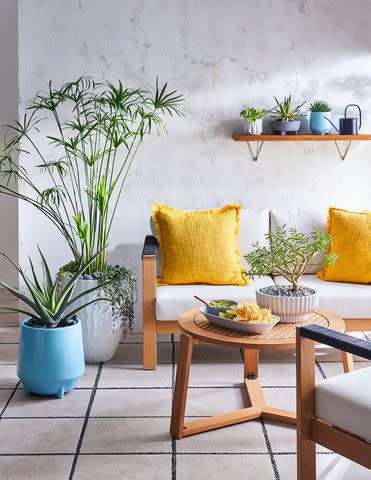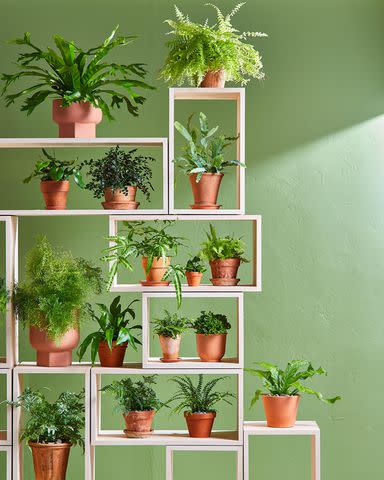How to Move Houseplants Safely to Your New Home
Help your plants make the move to your new place with these must-know tips.

Better Homes & Gardens / Carson Downing
Moving somewhere new can be a great time to start fresh, whether you’re relocating down the street or doing a cross-country move. Your houseplants may be less enthusiastic movers. Plants aren’t fans of big environmental changes, so a move can be hard on them. Your indoor plants may lose leaves, wilt, drop fruit or flowers, and generally display the botanical version of a temper tantrum. With time and proper care, these signs of stress should disappear. And then your plants can get back to living their best life in your new digs. These essential tips will help you move your houseplants to your new place in one piece (with your sanity mostly intact) and acclimate them more easily.
How to Prepare Houseplants for Moving
To ensure the smoothest move possible, switch out any ceramic and clay pots for shatter proof plastic options. It’s an easy way to avoid broken pots and protect plants from any unforeseen bumps in the road. Alternatively, try wrapping breakable containers in packing material like moving blankets or bubble wrap, just as you would do to any other fragile item. The goal is to prevent the pots from jostling around and shield them from getting hit hard enough to break.
:
Water, fertilize, and trim dead leaves or flowers a few days before the actual move. This way, your houseplants will be at their peak health during this change in scenery rather than already stressed. Don’t water your plants right before the move. It’s important that the soil is damp, but not wet. Soaking wet soil can lead to issues with freezing or mold growth, depending on the season.
If you're working with a moving company, make sure to check their guidelines, restrictions, and moving practices. Some won't move plants so you'll need to make other arrangements for transporting them.
How to Pack Small Potted Plants
After packing up everything but the kitchen sink, it’s time to work on your plants. Choosing to pack them last is the best way to ensure their safety during the move, while minimizing the stress on them. Prepare your smaller plants first. Because they easily can get lost in the midst of moving boxes or get crushed, find safety in numbers. Put all your smaller houseplants into a box together. Don’t forget to cut some holes in the top and the sides to increase airflow.

Better Homes & Gardens / Carson Downing
How to Pack Large Potted Plants
For large plants such as indoor trees, take a slightly different approach to protect big leaves and long branches from damage. Wrap newspaper or sheets of packing paper around the base of the pot and work your way up. This will help keep stray stems contained and give the whole plant a layer of protection during the move.
When moving your taller or bulkier plants, try to give them as much space as possible. This can be tricky when moving all your houseplants at once. During smaller moves, try taking more trips instead of taking your big indoor plants all at once. For longer-distance moves, multiple trips aren’t possible (especially when crossing state lines). In this case, pack your large potted plants into snug but not overly cramped places.
Editor’s Tip: Tall or large plants do best in moving vans or trailers. Don’t squeeze a plant into your backseat or have half of it sticking out the window. They need enough room so their branches and big leaves don’t break off or become damaged.
How to Move Plants in a Car
Get ready to buckle up. While seat belts are obviously meant to keep people safe, they can do the same for your plants. Large potted plants can go on a backseat with the strap secured around it (you may want to place an old towel or sheet of plastic under the pot to prevent staining your car). When you’re moving a box of plants, you can click the seat belt around it too. Because the back seat is roomier, the box of plants might move around. To avoid this, place the box of plants in the front seat. Move the seat as close to the dashboard as possible to help hold the box in place. This is also a helpful trick in the winter when temperatures are cooler, so your plants can be closer to the heater.
How to Move Plants in a Moving Van
For longer moves, it’s ideal to place your houseplants in the back of a moving van. That way, they're the last thing to be added, which will minimize their stress. Plus a tighter space with fewer objects makes for a safer move. Avoid stacking moving boxes too high around your plants because items could topple over during the drive and crush your prized fiddle leaf fig to a pulp. If possible, secure your nearby belongings to prevent shifting while the van is moving.
Keep in mind that a moving van may not have climate control in its cargo area. If you're moving during the height of summer or depths of winter, any plants on board may be killed by extreme temperatures. As a general rule, if it's not comfortable for you, it's not comfortable for your plants.

Better Homes & Gardens / Carson Downing
What to Do After the Move
Unpacking your houseplants should be the first priority after you get to your new home. Plants may seem a little droopy after a big move. It takes them a little time to acclimate to a new environment. Give them a hearty splash of water and find the perfect spot for them. This may mean an east or west facing window to get much needed sunlight or a spot on the porch. And of course, if any containers did break in the move, immediately repot those houseplants.
:

